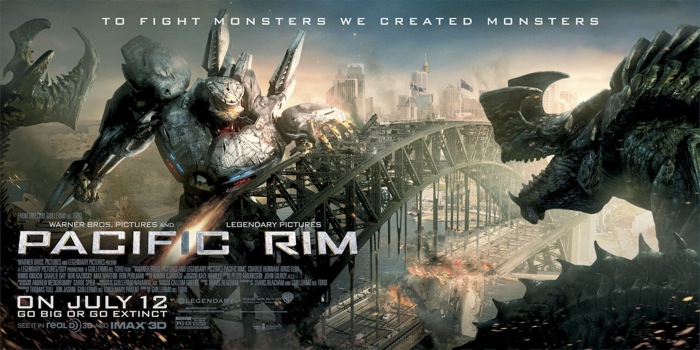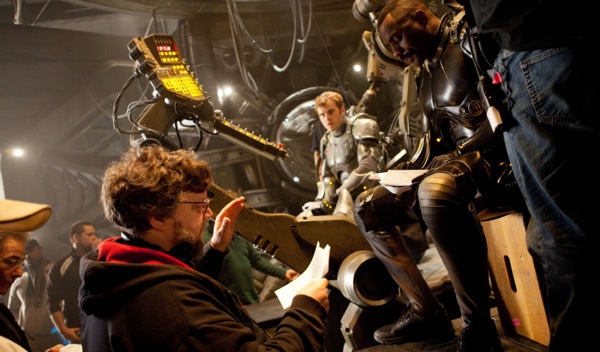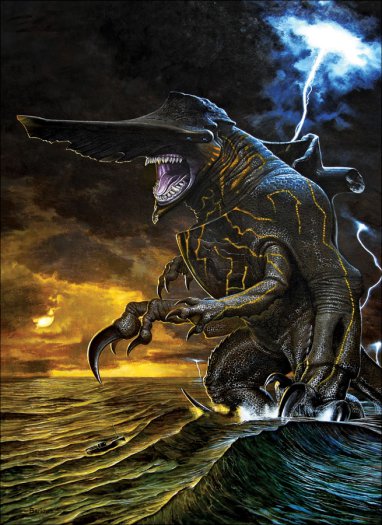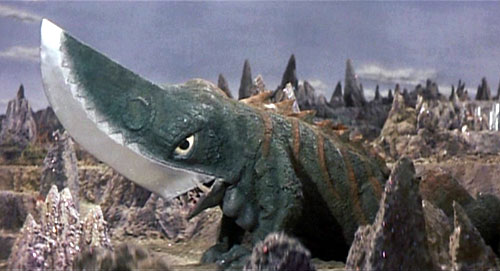
PACIFIC RIM is a science-fiction/fantasy hybrid that operates primarily on the "Wouldn't it be cool?" principle. "Wouldn't it be cool if humanity were under attack by giant monsters from another dimension? And, hey, wouldn't it be cool if, instead of attacking from outer space, they entered our world through a portal on the ocean floor? Oh, and, get this, wouldn't it be cool if the Earth's only hope for survival came in the 250-foot mechanical form of giant robots, which are piloted by two neurologically-linked human beings?" Screenwriter Travis Beacham thought it was cool. So did filmmaker Guillermo del Toro. And when Legendary Pictures' Thomas Tull agreed, the duo set to work on bringing to life an awe-inspiring amalgam of Godzilla movies, mecha anime and old-school Ray Harryhausen monster flicks.
For months, many people have gaped at the calamitous trailers for PACIFIC RIM and wondered how this city-leveling spectacle is any different from Michael Bay's TRANSFORMERS films. The answer's pretty simple: Bay's the kind of hyperactive brat who'd come over to your house and break all of your toys; del Toro is the good-hearted dreamer with boundless imagination who'd spin out some crazily expansive narrative incorporating every action figure at your disposal, no matter how disparate. You have fun with del Toro; you get grounded because of Bay.
But PACIFIC RIM is not the undisciplined work of an overgrown kid. It's an exuberant spectacle employing some of the most sophisticated special effects work I've ever seen from the geniuses at ILM, and, most importantly, a straightforward story about people overcoming their differences in order to save the world. For the first time this summer, parents can take their children to a PG-13 movie and not have to worry about the good guys snapping necks or getting their hearts carved out and eaten by William Fichtner. PACIFIC RIM may take place at the precipice of the apocalypse, but it's humanistic and ultimately hopeful.
And it is a kaiju-hurling blast to boot. Dedicated to Harryhausen and GODZILLA director Ishirō Honda, PACIFIC RIM is del Toro in unabashed crowd-pleasing mode; the Buñuel and Cocteau aspects of his artistic personality are decidedly less engaged here than in PAN'S LABYRINTH or THE DEVIL'S BACKBONE. But PACIFIC RIM is hardly a one-for-them obligation. Del Toro has exerted every ounce of his creative powers in designing this world. That this film's success could kick open the door for riskier, more grown-up projects like AT THE MOUNTAINS OF MADNESS is just a potential side benefit of what del Toro has accomplished here.
When I attended the PACIFIC RIM junket in San Francisco last week, I was scheduled to interview del Toro and Beacham separately for ten minutes. Fortunately for me, I was del Toro's last interview before lunch, which resulted in a relaxed, completely unexpected hour-long conversation in the Four Seasons restaurant. Given the length of the transcript, I'm going to present this interview in two parts: the first is mostly del Toro, with Beacham joining us near the end, while the second part will pick up with the two of them and conclude with Beacham solo. Over the course of our spoiler-free chat, we discussed influences (especially WAR OF THE GARGANTUAS), the particulars of world building, the establishing of tone and an epiphanic golden shower. You read that correctly.

Mr. Beaks: On the surface, PACIFIC RIM is the film we imagined as kids when we'd pit our Shogun Warriors versus Godzilla or whatever large monster toys we had sitting around. It's weird that films like this don't get made more often, because it really is about capturing and igniting the unfettered imagination of a twelve-year-old kid. What's more fun than that? Having that kind of license, did you feel any extra responsibility to get it right?
Guillermo del Toro: You always do. But your responsibility is always to deliver the movie on time and on budget, and that I am very good at. I really don't think your responsibility should extend anymore than that. I think that you have to let your imagination take you where you need to go. I am surprised at how hard it was to keep the movie simple. That is something where you understand that if you start catering to the more adult impulses of the genre, you start going for more of a dystopian or more existential slant, or you start going for the more - for lack of a better analogy - Bruckheimer older-adolescent impulses of the genre, it can derail the whole innocence that you need in a tale to allow for kaiju and mecha to coexist. When I tackled the movie, I was thinking of the adventure movies I saw as a kid, a throwback to an adventure movie where human virtue is possible, where even the bad guy among the human characters can convert into a guy that you learn to appreciate. Each of those characters brings a little bit of what's great about being human: leadership, intelligence, sacrifice. And to let the attack of a force of nature like the kaiju be the opposing force.
Beaks: Striking that tone and emphasizing the fun or, as you say, "innocent" aspects of this genre is much needed. Where does that other impulse come from, where people feel the need to make mainstream entertainment darker or more unsettling? Is it a reflection of the times in which we live?
Del Toro: I started in a really great way in the comic book world, when the term "graphic novel" was coined. Will Eisner does A CONTRACT WITH GOD, and maturity comes into the realm of superheroes in the form of really dark complexities. You have Alan Moore and Frank Miller to a degree bring pathos into the comic book world. And what you got was a explosion of sort of a "neuroses of the week". Superheroes started thinking about suicide and stuff like that. But at the end of the day they were still just superhero tales, which was what was great about them. But I think that started to translate into summer movies through the superhero genre, and through the bigger genre set pieces. I like those movies, don't get me wrong, but my aim with PACIFIC RIM was to almost not detract from one factor, which is when you are a kid and you watch a kaiju movie, there is a guiltless glee in the fact that monsters are destroying a city. There is no consequence. It has no relationship to the real world. There is never going to be a kaiju copycat attack because a kaiju saw a movie in a mall and he decided to destroy the mall. There is a glee to Gamera totaling a whole city block accidentally because he tripped. And one of the things I did is immediately vacate the cities in PACIFIC RIM. I said, "There should be no people in the street, nobody in the cars and nobody in the buildings so that we can really go at it." It's just material destruction in a fun way that is a staple in kaiju movies: it's not related to the real world. You need a little bit of innocence to allow that to happen.
Beaks: And there's a sort of innocence in the fighting style of the kaiju and jaegers. That's how we would imagine these battles as kids: a little professional wrestling, a little barroom brawl... I mean, if I were operating a jaeger, this is how I'd want to fight.
Del Toro: We did some of the classic kaiju movie moves, like lifting the kaiju up over your head and throwing it. We did a little bit of a wrestling grab with Leatherback. Especially as a Mexican kid, kaiju movies were the biggest wrestling movies ever, and they were advertised like that. KING KONG VS. GODZILLA: that's the movie! You don't need to know anything more. That's the purity of it.
Beaks: But you never get as silly as the fights in, say, GODZILLA VS. THE SMOG MONSTER.
Del Toro: (Laughs) No, no, but I like Hedorah.
Beaks: Again, that's the unfettered glee that you bring to this film. In constructing PACIFIC RIM, how difficult was it to stay focused and not get lost in the minutiae? There's so much fun stuff lingering on the periphery here.
Del Toro: This is the only movie where I've left the shaping of the story to the editing room. We knew what happened around the fights, but I shot about an hour more of material than is in the movie. Every character had a bigger arc, the characters were more complex. But I was really trying to strike the balance where I said, "We cannot pretend this is Ibsen with monsters and giant robots. I cannot pretend I'm doing a profound reflection on mankind." There are a lot of characters. We had about ten characters onscreen, so I said, "Let me try to get each character to its minimal requirements to have an arc that has a beginning, middle and end, and a payoff." If you think about it, even the scientists... they hate each other. One is right, the other is right, they both think they're right, but they learn to work together. Each of those little arcs was conducive to the same idea, which is "We can do this together." I think that's a great message to give kids. Something that doesn't have to have a militaristic approach, that has a humanistic approach. "That guy you were beating the shit out of ten minutes ago? That's the guy you have to work with five minutes later." That's life. It's not a complex message, but it's a message that I think is really simple. It's the same message I had in HELLBOY and, in a very different way, THE DEVIL'S BACKBONE. We can only be complete when we work together.
Beaks: Now that you've brought up the Ibsen version of this movie, I wonder how that would play.
Del Toro: (Laughs) There's a great adult movie to be made about drifting. But then it overpowers... you see, the most difficult thing in a movie is tone. And tonally, to get more deep into the drift sort of upsets the fantasy element of giant robots and giant monsters. There's a tone that you need to hit viscerally and dramatically that allows for the inherently outlandish premise that there are giant robots and giant monsters fighting on the streets.
Beaks: Is the drifting concept something you could see yourself exploring in another film?
Del Toro: We tried to do it in the comic book. We tried to do it in an adult way because we don't have the constraints of balancing a whole tone. They are separate little stories. But I think if we are lucky enough to do a second movie, of course the drift can be one of the things you explore more.
Beaks: One of the things that separates PACIFIC RIM from the other big films this summer is that it doesn't come from a preexisting intellectual property. How long did it take you to figure out the hook? How did you figure out how to introduce people to this world?
Del Toro: I knew that we needed to give the audience a glossary in the first three minutes of the film, sort of a primer of what world are we going to show you. I knew then that I wanted to show that world at its peak, when we were winning, when we were the best, when everybody was cocky, when killing a kaiju was just "Oh, another kaiju." And then I knew that I wanted to spend most of the movie on the time when we were the resistance, when we were losing and needed each other. So we needed to open the movie the way Anthony Burgess opens A CLOCKWORK ORANGE, with a glossary that tells you this is the speak: "'Kaiju', from the Japanese meaning 'Giant Beast'; 'Jaeger' from the German meaning 'hunter'." Then you go into nine images or so that we generated at ILM, and a prologue we generated at Mirada with sort of real-world footage: "This is what's going on, this is the news, these are the politics..." and then we go into the movie.
Beaks: Design-wise, whenever I watch one of your films or a film from one of your contemporaries who is also steeped in the history of classic monster movies, I always look for references or nods to those prior inspirations. Some people are more forthright about how they pay homage, but you don't really do overt reference.
Del Toro: I try not to. The DNA is there, don't get me wrong. The DNA of WAR OF THE GARGANTUAS is in the scene with the boat in the opening. I'm sure of that. The DNA of PATLABOR is in the DNA of how we conduct business in the Shatterdome. But by the same token, we went and scouted NASA. We photographed NASA. We photographed the Crawler, and we referenced the sounds of a Saturn rocket taking off. We based the Jaegers more in modern technology than on another robot in any other movie. I want to make a movie made by fans, but I don't want to make a fan movie. That's a big difference for me.
Beaks: Although you do seem to make a pretty direct reference with Knifehead.
Del Toro: He looks like Guiron.
Beaks: Who is one of my all-time favorite kaiju.


Del Toro: I love Guiron, too, but once you put them side-to-side, they don't look alike. What was funny is that Knifehead came from a silhouette Wayne Barlowe did, and he had never seen Guiron. I told him, "Go after a goblin shark." He started doing that, and for him it is guiltless; he never knew Guiron. Then we started riffing on that, and we created Axehead and Bladehead.
Beaks: When we were watching the ILM presentation yesterday, it was nice to watch parts of these sequences on a loop so that we could better appreciate the intricacies of the creatures' movement. That's a fun part of the film for fans: once we get this thing on Blu-ray, we'll be able to pause and study everything you've packed into the frame. But that detail is also something that will read for regular moviegoers without their knowing it. They'll appreciate it...
Del Toro: ... without rationalizing it. To me, when I was a kid and I saw STAR WARS, one of the things that blew me away - and I didn't realize it until later - was that everything looked damaged. Everything looked used. Tatooine or the Cantina or the streets or Boba Fett's suit, everything looked dinged, like it had gone through several years of use. That was a big lesson, but you don't verbalize it while watching it.
Beaks: Did you watch any films in preparation for PACIFIC RIM?
Del Toro: You know, I didn't on this one. I thought my preparation for this movie was having watched those movies as a kid and a young adult and as an adult. I carried them, and I decided against watching them. I said, "If I start watching them, it's going to block something." So I told everyone on the design team, "Let's not communicate through homages. Let's try to communicate in the language as if we were doing it for the first time." And then I would say, "Let's do a classic kaiju move like lifting the guy in the air," because I knew it was there. We were of course influenced by PATLABOR, TETSUJIN 28, VOLTRON, SPACE GIANTS, and ULTRAMAN, but we didn't consult them like a Bible.
Beaks: And yet it must be difficult, because those things are inescapable.
Del Toro: Inescapable! You can never escape GODZILLA if you're making a kaiju movie! And you can never escape, in my opinion, TETSUJIN 28 if you're making a giant robot movie.
Beaks: What is your favorite kaiju movie?
Del Toro: A sentimental one for me is a kaijin film called FRANKENSTEIN CONQUERS THE WORLD, which is closely followed by WAR OF THE GARGANTUAS. They were movies that I saw at the right age, and they blew my mind. Now I see them again, and they are not as impactful, but when I was a kid they were like GONE WITH THE WIND with giant monsters for me. (Laughs)
Beaks: When I was a kid, I cried at the end of WAR OF THE GARGANTUAS. I was fortunate enough to have an older brother who was into this stuff, and we'd always get excited for "Giant Monster Week" on the afternoon movie, which would invariably include WAR OF THE GARGANTUAS. They had to show it.
Del Toro: It's amazing. I heard that it became in the '80s a very big stoner movie, and I can see why. But for me, my earliest memory of WAR OF THE GARGANTUAS was that it opened in a theater on the other side of town. I took a bus solo, as a kid, all the way across town. It was what we call in Mexico a "brick cinema", because they give you a brick for the rats as you came in.
(Guillermo hits pause on his story as the publicist brings Travis Beacham to the table. Guillermo remarked earlier on Beacham's new haircut, and takes this opportunity to make a crack.)
Del Toro: Hey, it's Justin Bieber!
Publicist: Jeremy, this is Travis.
Del Toro: How are you doing Biebs?
Travis Beacham: Good to see you!
Beaks: Great to meet you!
(Del Toro resumes his story.)
Del Toro: So I was watching the movie, and I was under the balcony, and a huge glass of pee fell from the balcony on my head. This is how much I love kaijus: I stayed and watched the ending.
Beaks: And that day you were baptized.
Del Toro: I was baptized in a very Clive Barker way, like Rawhead Rex!
Beaks: (Laughing) This explains everything.
(The waitress drops by the table to take Beacham's order: grilled cheese. I suddenly regret my choice of caesar salad. After a little small talk, we begin talking about the movie again.)
Beaks: I saw the movie three weeks ago, and I sat next to Drew McWeeny and his two sons. I was actually right next to his older son, Toshi, and our reaction to the film was pretty much identical: laughing, clapping, leaning in, cheering... I was so happy to have that experience. I have a nephew who's about Toshi's age, and I doubt I'll be able to see it in the theater with him.
Del Toro: I think it's the youngest film I've done. It makes HELLBOY II look like THE GARDEN OF THE FINZI-CONTINIS. It really would be great to put the message out there that it's a family movie, that kids are going to enjoy the hell out of it. I really hope that the trust that is put into PG-13 in the summer gets to hold by the time we open, because a lot of the PG-13 movies this summer are getting too intense for kids.
Beacham: It reminds me of JURASSIC PARK in that way. When I was a kid, that was the movie that made me want to make movies.
Del Toro: Are you that young? How old are you?
Beacham: I'm thirty-two.
Del Toro: My god. He's a child, Beaks! A child!
Becham: It made such an impact. I wanted to be a paleontologist for a long time, and that stemmed from my childish love of dragons. I loved monsters, and dinosaurs were like real monsters. But as I got older, I realized I was just going to be digging up the bones; I'm never going to see these things alive. So when I saw JURASSIC PARK, and they're walking up the hill and first see it, it was alive to me in that moment. It was a living thing, and I wanted that magic so bad.
Del Toro: I just hope kids get to see it.
Beaks: Well, as you said, it comes down to that trust in the PG-13. In my world, this would be a PG film.
Del Toro: In my world, it would be, too. I was surprised the MPAA gave us a PG-13. But they gave us an R on DON'T BE AFRAID OF THE DARK, so you figure it out.
Beaks: We're talking about JURASSIC PARK, which is scary as hell, but when you're a kid it's fun to be scared sometimes. You may be freaked out while you're watching it and have nightmares later, but when you get older you'll appreciate those moments. It depends on the kid, of course, but it's good to experience a scary movie on occasion.
Beacham: And there are so many kinds of violence, and so many different kinds of scares.
Del Toro: When you have violence that has a consequence that is either biologically real or socially real, I think there is caution to be had. If you're ripping apart a human being, or if there's an explosion in the mall, or if you're discharging a high-caliber-firepower weapon in a crowd, of course there's a real-world consequence to it. But... knock on wood.
Part two of our interview is coming tomorrow. PACIFIC RIM is coming this Friday, July 12th. Go.
Faithfully submitted,
Mr. Beaks
